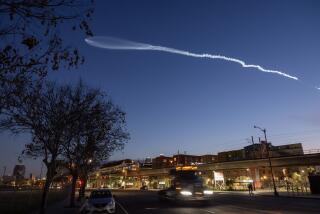Navy Town’s Feeling Keelhauled
- Share via
GROTON, Conn. — Two hundred yards from the nation’s oldest submarine base, the day manager of Golden Gate Pizza could barely focus on who had ordered pasta and who wanted the pastrami grinders.
As with just about everyone else in Groton, Tina Way was reeling from the news that the base might be shut down. All she could think about was what a huge blow that would be for every layer of this community.
“It will be devastating,” Way said. “These people [at the base] are like family to us.”
Much of the “Submarine Capital of the World,” as this community of 40,000 has long billed itself, was struggling to process the fact that Naval Submarine Base New London was included in the Defense Department’s latest round of recommended closings and consolidations.
Groton Utilities Director Glenn Wilson compared his reaction to learning that someone he loved had a fatal disease. State Sen. Catherine Cook said she felt as if she had been kicked in the stomach. Carol Kimball, the 88-year-old town historian, said she was heartbroken.
Starting with Groton’s emblem, which features a submarine, everything about this 300-year-old town on the banks of the Thames River is connected to the base, said Mayor Harry Watson. Though neighboring New London raised most of the money to land the base in 1868, the best location turned out to be in Groton, but the name New London stayed attached. Its proposed shutdown represents the single largest loss of jobs of any of the base closings recommended Friday by the Department of Defense.
An economic impact report prepared by the state showed the base closing would cause 31,500 people in the area to lose their jobs, said John Markowicz. The 61-year-old Naval Academy graduate is head of the Subase Realignment Coalition, a group that has fought to keep the 687-acre base open since it was nearly closed in 1993.
For perspective, he said, the total employment figure for southeastern Connecticut is about 100,000. “We stand to lose about one-third of our jobs,” Markowicz said. “We are wiped.”
More than 7,500 military personnel work at the submarine base -- along with 650 reservists and several thousand civilian workers and contractors.
A state analysis showed that if the base closed and if the largest adjacent business, General Dynamic Electric Boat, also left town, the cost to Connecticut would be about $3.3 billion per year, said Cook, the state senator. But she emphasized that those numbers failed to describe the full toll.
Cook said 750 contractors around the state derived their livelihoods from the submarine base, including software developers, simulator manufacturers and makers of precision instruments. And in Groton, car dealers, retailers, barbers and beauticians, restaurateurs, real estate agents, grocers and moving company owners rely on the submarine base for large portions of their business.
Forty percent of Groton schoolchildren come from Navy families, Cook said. Navy retirees who remain in the area receive their healthcare at the base, she said.
“We are patriotic people, and this base is part of our culture,” she said. “I just can’t think of what my community would be like without the base.”
Just outside the base, Corey LaPlace was delivering Coca Cola to a convenience store.
“The base is big business, about 70% of our gross business,” he said. There are more than 1,000 vending machines on the base alone, LaPlace said, adding that he also delivers to the base hospital and mess halls.
And it is business from the base that means the local Domino’s Pizza needs 80 to 100 cases of Coke delivered each week, LaPlace said. “What happens to that when the base closes?”
Although closing the base had long been threatened, many in the area questioned why the federal government would eliminate an important military installation midway between New York and Boston.
The base at Groton, where the first nuclear submarine was christened by First Lady Mamie Eisenhower in 1954, hugs the river banks, its 134-foot submarine escape training tank towering over the landscape. As with a number of other facilities faced with being phased out, it is seen as a relic of the Cold War, some analysts said.
Under the Pentagon closure and consolidation plan, the Groton base would be phased out over five years. The submarine force would be relocated to bases in Norfolk, Va., and King’s Bay, Ga. It is one of 33 major bases that the Pentagon has marked for closure and must be approved by the base realignment commission, Congress and President Bush.
Elsewhere on the Northeast coast, the Portsmouth Naval Shipyard in Kittery, Maine, and Otis Air National Guard Base on Cape Cod, Mass., also would be shut down. Those two and Groton combined account for 14,500 workers -- about half of the total number of military jobs that would be lost nationwide as a result of the proposed closings.
On Saturday in Groton, Chuck Bowe was juggling four paper plates heaped with hot dogs he bought for his family at a charity barbecue. Bowe said he plugged every penny he had into the purchase of two Groton liquor stores in November.
While a gradual phase-out of the base might help him keep Grand Wines and Spirits alive temporarily, it wouldn’t be for long, he said.
“If they pull the plug, 40% of my business would be affected immediately,” Bowe said. “The contractors would go immediately, and I would feel an immediate impact. Everything I have is tied up in these businesses. It is all on the block.”
At Fisher Florist, the family-owned flower store where he has worked for more than 30 years, George Fisher said that departing submarine sailors routinely placed flower orders for upcoming weddings, anniversaries, christenings and birthdays before they left on maneuvers.
“Right now, I have two subs on patrol,” Fisher said. “I provide all the flowers for the families of these guys when they are gone. When that business goes, it’s 30% of my business.”
Fisher said he also was worried about how the community overall would fare. Base personnel volunteer in the community -- recently helping to rebuild a camp for disabled children, for example, Fisher said. Their spouses hold jobs, and some from the base are elected to local and state office.
“The Navy families that come and go are always so civic-minded,” said town historian Kimball. “They take great pride, and participate in every phase of the community.
“I just can’t picture Groton without the sub base. It is just terrible. I am just heartbroken by the whole thing.”
As a bitter wind whipped across the Thames River late Saturday, Art Brice said he traveled to Groton from his home in Oakhurst, Calif., so he could relive fond memories of his Navy days at the submarine base in the 1970s.
Brice stood outside the namesake museum of the Nautilus, the first ship powered by nuclear energy. The large black submarine loomed behind Brice as he expressed shock at the possible closure of the base.
“I have a lot of good memories here,” he said, recalling how he and his buddies liked to go out eating and drinking in the area. Brice also recalled how important the base was in the development of the country’s “silent service,” the submarine corps.
“And then they say they are closing it down,” he said. “How do they close down history?”
But Watson, the mayor, said he had no intention of allowing the base to disappear without a fight. “I don’t have that attitude. That is like laying down and playing dead.
“We’ve beat this before, when they said they would close it the last time. It’s just going to be a little harder this time.”
Watson has convened a special meeting of the Groton Council for Tuesday. He said it would work with Markowicz’s coalition to mount an appeal to the Base Realignment and Closure Commission.
“I think we need to unite together as a community and fight this, because it is wrong,” Watson said. “I think we need to put our dukes up.”
*
(BEGIN TEXT OF INFOBOX)
Pentagon hit list
The Pentagon wants to close 33 major bases. A ‘major’ base is one whose replacement would cost $100 million or more. Here are the bases and their home or nearby city.
Base and jobs affected
*
Alaska
Kulis Air Guard Station, Anchorage: 459
*
California
Naval Support Activity, Corona: 892
Onizuka Air Force Station, Sunnyvale: 278
Riverbank Army Ammunition Plant: 89
Naval Weapons Station Concord: 71
*
Connecticut
Submarine Base New London, Groton: 8,460
*
Georgia
Ft. McPherson, Atlanta: 4,141
Naval Air Station Atlanta, Marietta: 1,498
Ft. Gillem, Forest Park: 1,081
*
Indiana
Newport Chemical Depot, Terra Haute: 571
*
Kansas
Kansas Army Ammunition Plant, Parsons: 167
*
Louisiana
Naval Support Activity New Orleans: 2,711
*
Maine
Naval Shipyard Portsmouth, Kittery: 4,510
*
Massachusetts
Otis Air National Guard Base, Falmouth: 505
*
Michigan
Selfridge Army Activity, Mt. Clemens: 300
W.K. Kellogg Airport Air Guard Station, Battle Creek: 274
*
Mississippi
Naval Station Pascagoula: 963
Mississippi Army Ammunition Plant, Slidell/Gulfport: 54
*
Nevada
Hawthorne Army Depot, Reno: 199
*
New Jersey
Ft. Monmouth, Red Bank: 5,272
*
New Mexico
Cannon Air Force Base, Clovis: 2,824
*
New York
Niagara Falls International Airport Air Guard Station: 642
*
Oregon
Umatilla Chemical Depot, Hermiston: 512
*
Pennsylvania
Naval Air Station Willow Grove: 1,232
Pittsburgh Interntional Airport Air Reserve Station: 322
*
South Dakota
Ellsworth Air Force Base, Box Elder: 3,852
*
Texas
Brooks City Base, San Antonio: 2,923
Red River Army Depot, Texarkana: 2,500
Naval Station Ingleside: 2,218
Lone Star Army Ammunition Plant, Texarkana: 149
*
Utah
Deseret Chemical Depot, Tooele: 248
*
Virginia
Ft. Monroe, Hampton: 3,564
*
Wisconsin
Gen. Mitchell Air Reserve Station, Milwaukee: 266
*
Sources: Department of Defense; GlobalSecurity.org.
Graphics reporting by Tom Reinken
*
Getlin reported from Groton, and Mehren from Boston.
More to Read
Sign up for Essential California
The most important California stories and recommendations in your inbox every morning.
You may occasionally receive promotional content from the Los Angeles Times.












